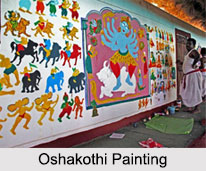 Oshakothi paintings, also known as Kothisala paintings are done on the indoor walls by malis, peasant communities and fisher folks. These are done on the verandah of a private house or just on a temporary bamboo wall, which is prepared for Oshakothi paintings or Kothisala paintings. Oshakothi paintings are prepared during Dussehra in the month of September or October, particularly in Ganjam District, Odisha.
Oshakothi paintings, also known as Kothisala paintings are done on the indoor walls by malis, peasant communities and fisher folks. These are done on the verandah of a private house or just on a temporary bamboo wall, which is prepared for Oshakothi paintings or Kothisala paintings. Oshakothi paintings are prepared during Dussehra in the month of September or October, particularly in Ganjam District, Odisha.
The word "Oshakothi" refers to a house, a square or rectangular-format or a diagram. The central theme of Oshakothi painting is the "Mangala" or the "Nritya Shiva" on Nandi. The area is divided horizontally and vertically into several compartments for Oshakothi paintings. Oshakothi paintings are a unique cultural tradition that reflects different rituals which is being observed by the underprivileged class of people in south Odisha.
Development of Oshakothi Paintings
The tradition of Oshakothi paintings is nearly more than 200 years. There is a prospect that the traditional Oshakothi paintings might be influenced by tribal culture, particularly by Saura paintings. The development, in the manner of Oshakothi painting, is due to the impact and influence of up to date lifestyle which is noticeably visible in Oshakothi paintings. The art of Oshakothi painting is hard to find now-a-days. There is a huge demand for traditional Oshakothi painting art.
Significance of Oshakothi Paintings
Oshakothi paintings are inspired by the religious group of fertility and are done for the welfare of the village and for a good harvest. They are also done to fulfil the specific desire of a family on an individual to get a son. These paintings reflect the religious outlook of the village which accommodates all the gods and goddesses of the village and the locality in one great vision. Along with Mangala or Lord Shiva, Ganga, Vimala, Saraswati, Durga, Lord Ganesha, Kartikeya, Chamunda, Vanadevi and other forms of the mother goddess are painted in comparatively larger niches. The villagers have tremendous faith in the Oshakothi paintings as well as in the rituals.
Styles of Oshakothi Paintings
The important motifs of Oshakothi Paintings are "Satabhau" (seven sisters) with water pitchers on their heads, "Gajabhima", "Hanuman", "Bankeswari", "Manikeswari", "Dhoba dhobani" (washerman and his wife), "Hadi hadiani" (scavenger and his wife), "Kandha Kandhuni" (Kondh and his wife) and "Jani Janiani" (priest and his wife). The motifs include classical deities, folk deities and all the other popular deities of the locality. The painter is either a professional chitrakara, or any other painter from the community who is commissioned by the organizers.
Features of Oshakothi Paintings
The most important aspect of their paintings is the ritual associated with them. Each evening the villagers gather in front of the painting. The paintings on the wall are offered lamp, incense and camphor. While these rituals are still going on, a character appears dramatically from the crowd, goes near the painting, bows to a particular motif, says "Mangala", and slowly starts dancing, gently moving his body in a semi-trance state and gradually entering into a state of ecstasy. He dances to the tune of the dhanakoila (an improvised earthen drum) with the singing beats of the gayana. The man possessed of the spirit is called "Devata", meaning a deity. The Devata answers several questions posed by the gathering villagers. This ritual is repeated on several successive evenings.



















